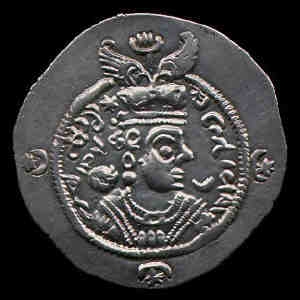|
Family Links
|
|
Spouses/Children:
Unknown
|
|
|
Yazdigird III Sassanid King of Sasanian Empire [60511]

 General Notes: General Notes:
http://www.rpi.edu/~holmes/Hobbies/Genealogy/ps31/ps31_262.htm
Yazdgird III, the grandson of Khusrau, ascended the throne in 632 but did not receive the support of the Persian nobility in the face of the invasion to follow. The Persian army under the general Rustam was defeated at Qadisiyya, near Hira (636). In 637 the armies of Islam occupied Ctesiphon. Yazdgir's appeal for Chinese aid went unanswered (638). The Arab army swept over the Iranian plateau and wiped out the imperial Sassanian army at Nihavand (642). Yazdgird fled to Merv, where he was murdered while hiding in a mill (651). Sassanian rule had ended, and the Persian provinces were incorporated into the caliphate.
The battle of Nihavad (642) and the last battle of Qadisiya (651) were the two events that sealed the end of the Sasanian era.
http://en.wikipedia.org/wiki/Yazdgerd_III
Yazdgerd III (also spelled Yazdegerd or Yazdiger, Persian : Óęć , "made by God") was the twenty-ninth and last king of the Sassanid dynasty of Iran and a grandson of Khosrau II (590\endash 628). His father was Shahryar whose mother was Miriam, the daughter of the Byzantine Emperor Maurice .[1] Yazdgerd III ascended the throne on 16 June 632 after a series of internal conflicts.
Life and Reign
Yazdgerd III reigned as a youth and had never truly exercised authority. The Islamic Conquest of Persia began in his first year of reign, and ended with the Battle of al-Qadisiyyah . Yazdegerd sought an alliance with Emperor Heraclius , who was an old rival of the Persian Empire .
Following the battle of al-Q the Arabs occupied Ctesiphon , and the young King fled eastward into Media going from one district to another, until at last he was killed by a local miller for his purse at Merv in 651.[1] <http://p2.www.britannica.com/oscar/print?articleId=106324&fullArticle=true&tocId=9106324>
The rest of the nobles who fled settled in central Asia where they contributed greatly in spreading Persian culture and language in those regions. They also contributed to the establishment of the first native Iranian dynasty, the Samanid dynasty, which sought to retain some Sassanid traditions while still promoting Islam.
Zoroastrian Calender
The Zoroastrian religious calendar , which is still in use today, uses the regnal year of Yazdgerd III as its base year. Its calendar era (year numbering system), which is accompanied by a Y.Z. suffix, thus indicates the number of years since the emperor's coronation in 632 AD.
Family
Yazdgerd's son Pirooz II fled to China . Yazdgerd's daughter Shahrbanu is believed to be the wife of Husayn ibn Ali . Yazdgerd's other daughter Izdundad was married to Bustanai ben Haninai , the Jewish exilarch . Persian religious leader Bahaullah 's ancestry can be traced back to Yazdgerd III.[2][3]
References
This article incorporates text from the Encyclopędia Britannica, Eleventh Edition , a publication now in the public domain .
1. ^ Encyclopędia Britannica Fifteeth Edition
2. ^ Balyuzi 2000, pp. 9-12
3. ^ Effendi 1944, p. 94
Genealogy of the Byzantine-Persian royal lineage <http://www.american-pictures.com/genealogy/persons/per03118.htm>

Yazdigird married.
|





